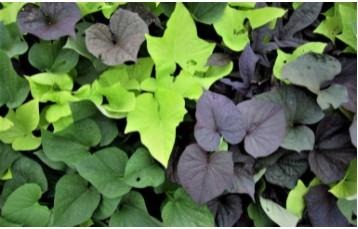Ornamental sweet potatoes, a popular cover option in landscape bedding and container mixes for years, have been named the latest Texas Superstar.
They are warm-season annual selections of the same plant species that produces tubers loved by foodies, but these are primarily chosen for their tropical-looking foliage as a heat- and drought-resistant ground cover, said Brent Pemberton, Ph.D., Texas A&M AgriLife Research ornamental horticulturist and Texas Superstar executive board member, Overton.
“There are too many varieties to dive into, but the new and old selections available are great for Texas,” he said. “They’re drought tolerant and provide great annual cover. Ornamental sweet potatoes are one of those plants that should have been a Texas Superstar already. We want to highlight them as a wonderful option for landscapes and as a filler or spiller in planters and containers.”
Their foliage comes in a wide range of colors, including chartreuse, purple, bronze, red and variegated, which has made them a staple in Texas landscapes, Pemberton said. Leaf shape can be oval to egg-shaped to deeply lobed or heart shaped.
Vines can be quite vigorous with newer varieties being less aggressive, Pemberton said.
“Ornamental sweet potatoes are grown as an annual ground cover that performs very well in a variety of landscape and planter situations,” he said. “The tubers produced by ornamental varieties are typically bitter compared to their edible relatives.”
To be designated a Texas Superstar, a plant must perform well for growers throughout the state. Texas Superstars must also be easy to propagate, ensuring the plants are widely available and reasonably priced.
Get to know ornamental sweet potatoes

Ornamental sweet potato plant varieties come in a wide range of colors and foliage shapes. Mixing varieties like this can provide an added element to their use in landscapes or planters.
Full sun is best for plant and color performance, but some shade is tolerated. Some chartreuse varieties will bleach in full sun but perform well with some shade.
Plants typically grow from 8-14 inches tall and spread along the ground. Older types can ramble 4 feet from the crown and beyond, but newer varieties spread less aggressively, Pemberton said.
Ornamental sweet potatoes are mainly used as ground cover but can be used as an accent plant in mixed borders. Less aggressive types can be used as spillers in mixed containers, and a few specific cultivars can grow vertically along trellises.
Pemberton said it is best to plant actively growing plants from containers in the spring when night temperatures are above 55 degrees because temperatures 45 degrees and below can cause chill damage. The ornamental sweet potatoes also tolerate summer planting well. They are adapted to a wide range of soil types and pH levels as long as drainage is good with no standing water.
Their vigorous growth habit makes fertilization mostly unnecessary, and plants may be pruned freely to keep them in bounds, Pemberton said. Foliage is also tolerant to deer grazing, but flea beetles can cause some damage, including pits and small round holes.
“These are great plants that can last the whole spring and summer up to the first frost,” he said. “They are prolific growers and provide sprawling foliage that can fill beds and provide standalone color or contrast for ornamental flowers.”
Texas Superstar is a registered trademark owned by AgriLife Research, a state agency that is part of the Texas A&M University System. Plants are designated Texas Superstars by the Texas Superstar executive board, which is made up of nine horticulturalists from AgriLife Research, Texas A&M AgriLife Extension Service and Texas Tech University.
Source : tamu.edu